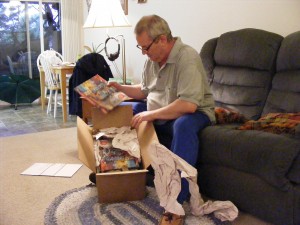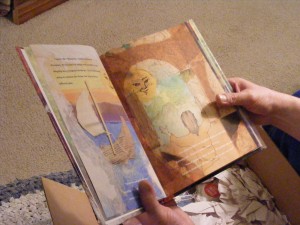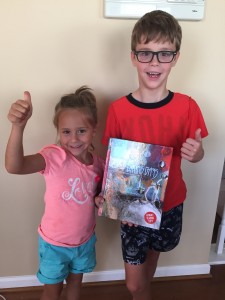Before I saw her, I heard her rustling in the tall grass on the bank above me. I looked up, and then I saw her. Her rump, back, neck, head, with ears standing tall and alert: a doe. She stopped when she spotted me. I raised my pocket-size video camera, on a lanyard around my neck, and recorded a glimpse of her. I was in a kayak, several yards below her, on Scappoose Creek.
My kayak was a bright yellow Necky Rip 12. It includes a rudder, or a “Built in drop down skeg,” (from its official specs at the Necky website), which is not used for steering, but to keep it on a straight course. I found this to be a very nice feature. Wikipedia includes a paragraph about the use of the skeg in kayaks; however, this paragraph states: “Typically, these are retractable, and they are not a rudder.” So now you know: a skeg is not a rudder after all. To view this kayak up close, click on this link –
http://www.neckykayaks.com/Kayaks/Recreation/Rip_12/
We pulled into the Scappoose Bay Marina just before 9:30 in the morning. Scappoose Bay Kayaking is situated below the main parking lot, where all the pick-ups with empty boat trailers are parked. It’s located in Warren, Oregon, just off of Highway 30. I had made a reservation online, and so our kayaks were already waiting for us at the dock. The “boat handler” who was assisting us supplied a laminated aerial photo as a map, and he recommended that we paddle east, and then into Scappoose Creek, since it was our first time on the bay.
My companion wanted to try the Hobie Mirage Revolution 13, also known as “Rev 13” by the guys at the kayak shop. It is essentially a sit-on-top kayak – with pedals. Of course, it also comes with a paddle. So the Hobie Rev 13 equals paddle plus pedal. Or just drift with the current, which we both enjoyed. My companion commented that the Rev 13 feels very stable in the water, due to its MirageDrive pedal with a dual-fin suspended beneath the kayak. Hobie’s website describes the MirageDrive with Glide Technology as “sheer efficiency.” It states: “With the largest human muscle group now in play, kayaking becomes easier and more efficient than ever. …The Click and Go mounting system allows you to quickly remove the MirageDrive for cleaning or storage,” or to switch to another style of fin. To see more about this kayak, follow this link –
http://www.hobiecat.com/mirage/mirage-revolution-13/
The entire staff at Scappoose Bay Paddling Center provides excellent, professional customer service. A boat handler personally assisted each of us, my companion and me. On the dock, they helped us get into our kayaks, and then, somehow, they were right there, waiting for us, when we returned, to help us get out again. Before we paddled away from the marina, they instructed my companion on how to handle the Hobie Rev 13, because this was the first time that she’d used one.
Glistening mud (or silt) on the banks greeted us as we paddled away from the marina, around the short row of houseboats, and into the main channel headed east. We saw an abundance of herons, standing on the glistening silt, stalking their prey. This was due to the fact that the tide was going out – the times of high and low tide were posted on a white board inside the kayak shop. We were surprised that the Columbia River, of which Scappoose Bay is an offshoot, would be affected by the tide this far upstream. Sometimes a heron took flight, with its huge wingspan, as we drifted by.
The water’s absolutely placid surface impressed me; although it sounds cliché, it provided a smooth, mirror-image reflection of all the details along the shore, including the blue sky with a few clouds. There was no strong wind, only a light breeze; in fact, I could feel the breeze only when I stopped paddling because I was paddling at the same speed as the breeze. The morning began with very warm sunshine; but during the course of our outing, it became briefly overcast, and then sunny again.
The sheer quietness also impressed me, a stillness that was interrupted by the sound and sight of fish jumping, of which we saw many. We witnessed a huge fish jump twice with a big splash each time, once very close to me. At one point, I imagined a fish jumping right into my kayak!
We left the main channel and paddled into the calm, unruffled Scappoose Creek. Tiny dragonflies hitchhiked on our kayaks. We paddled comfortably upstream, enjoying the undisturbed tranquility. I realized that at this spot on the earth, there was absolutely no other person – just my companion and myself. I adore this kind of solitude (which is one of the main reasons I find kayaking hugely appealing). I wish it could last longer than a brief, morning paddle. That is a goal that I have: to be able to extend this kind of experience.
Soon we reached a place where the creek divides, apparently split by an island. This was our midway point, the spot at which we needed to head back. It’s the time to briefly rest and restore energy with a nutritious snack: apple slices, cheddar cheese, sausage, carrots, water, pumpkin seeds – shelled and seasoned. As we rested without paddling, we began to drift backward with the current. So I turned my kayak around to face the direction that I was floating. As I continued drifting, my kayak was being steered by the slow current: a combination of the tide going out and the creek’s current. For the moment, I didn’t need to paddle. So I continued to snack while I was drifting.
That’s when I encountered the doe. I heard rustling in the tall grass. I looked up, and then I saw her. I said to my companion, not too loudly so I wouldn’t scare the doe, “Can you see the deer?” But there was no response. I lifted my camera to shoot a short video. By this time, I had drifted a ways downstream, and I was close to the bank.
I wanted to turn my kayak around to see why my “buddy” hadn’t responded. I pushed away from the bank with my paddle, and it was grabbed by the thick, soggy silt. But I jerked it free. With my kayak turned to face upstream, I could see that my companion was quite far back; no wonder she hadn’t heard my voice.
I waited for my buddy to catch up to me, and then we continued together. Reaching the mouth of the creek, we tried paddling into another tributary. I went ahead to test the depth, but it appeared too shallow, especially for the Hobie with its “propellers” beneath the hull, and it was becoming shallower by the minute. So we turned around – while the 13.5-foot Hobie could still be turned – and headed back into the bay. It would be a very different experience with a higher tide, and much more of the area inundated.
At this point, I felt my left leg begin to ache, and I wondered why. It almost never happens when we’re kayaking. And then I realized that we had remained in our kayaks for the entire length of the outing. We usually beach our kayaks at the midway point and take a break, getting out of the kayak to stretch our legs. But this time, we weren’t able to do that. That is also why this was the driest paddle of my experience so far. By not beaching the kayak and getting out, even my feet stayed dry!
During our return trip, my companion commented: “I can just imagine doing this,” implying that she loved the Rev 13, and that if we lived closer to water, she could imagine just dropping the kayak into the water, and going for a paddle, whenever she wanted. It combines the benefits of bicycling with the pleasure and peacefulness of being on the water. I said that next time, I will rent a Rev 13, too.
It was an excellent, late-summer day, along with superb customer service and equipment provided by the Scappoose Bay Paddling Center. This is a complete paddling center offering rentals, lessons, tours, sales and accessories. The shop is clean, bright, modern, and well-stocked with kayaks from Hobie, Necky and Eddyline. Here’s the link to visit their website –
http://www.scappoosebaykayaking.com/kayaking
Or you can call toll-free: 1.877.2PADDLE.
Before our outing, the young woman helping us mentioned that we might see some turtles along the way. There are photos of local turtles and eagles under the glass on the counter. When we returned, I commented that we saw neither, although I did see the deer. A young man was standing nearby—I think it was Bru—and he asked if we saw the Scappoose Moose. I fell for it, with an uncharacteristic display of gullibility. Then he clarified: “Some people call them cows.” Then the young woman (I think her name is Heather) gave us a card entitling us to one hour free rental after renting four times. A little bit later, I overheard her talking on the phone about reserving an activity for around twenty students; Scappoose Bay Kayaking also partners with Next Adventure.
A very important sidenote: while driving home, we noticed Fultano’s Pizza—same as the one in Cannon Beach—along Highway 30 near Scappoose; we will stop there next time we come kayaking here.
Soon you may be able to see video footage of this trip, including the Hobie Rev 13 in action, at my YouTube channel, Lee Cuesta Live. Here’s the link to my channel –
https://www.youtube.com/user/leecuestalive
And I encourage you to read my intermittent posts about my kayak adventures, which began with “Lives Not Governed By The Monotonous Routine.” (Here is the link: https://www.leecuestalive.com/?p=110 .)
Lee Cuesta
 In these photos, I am opening the box from the publisher, on the day it arrived, containing the ARCs.
In these photos, I am opening the box from the publisher, on the day it arrived, containing the ARCs.

